hehe, lot's of words on this page already 😀
As comparison, here is a another midrange driver that can do 100db at 300Hz with about 2Watts of power and 0.5mm excursion. But, it's got so big cone area (15") it would beam quite bad at few kiloHertz. No problem with distortiom though, so it's system desing issue whether it's important to have 5kHz xo for mid or loads of SPL capbility and consequently low distortion. This midrange with 18" bass could do 116db from 44Hz and up and uplive the neuman minimonitor spec 😀 Anyway, have fun.
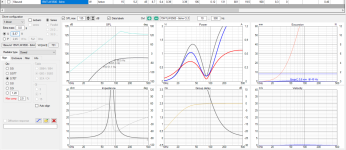
As comparison, here is a another midrange driver that can do 100db at 300Hz with about 2Watts of power and 0.5mm excursion. But, it's got so big cone area (15") it would beam quite bad at few kiloHertz. No problem with distortiom though, so it's system desing issue whether it's important to have 5kHz xo for mid or loads of SPL capbility and consequently low distortion. This midrange with 18" bass could do 116db from 44Hz and up and uplive the neuman minimonitor spec 😀 Anyway, have fun.

good evening 🙂 before replying to the last advices i found something
https://www.neumann.com/en-us/products/monitors/kh-150

https://www.neumann.com/en-us/products/monitors/kh-150
thank you very much for your kind and very helpful adviceEven if manufacturers did, my skepticism would not fully believe them and I would want the drivers third party tested. Perhaps the manufacturers know that anyone who delves so deep into the performance of a driver will also want them independently tested so they don’t even bother? Purely guessing.
in the meantime i have found what i meant so someone shares my interest in the end
https://www.researchgate.net/figure...eaker-exhibiting-high-Rub-Buzz_fig2_267698405
this is a very common test for electronics but extremely rare for speakers i wonder why
very easy to perform with a calibrated mic and a spectrum analyzer
then we can discuss if the 2nd order harmonics are less detrimental of 3rd and so on
but my point is that the audio chain ends after the speakers Not before them
Therefore i would be curious to see the entire audio chain tested
Considering the very low and the highs are less impacting on the ear i would use testing signals in the midrange
Wow ! thank you very much I will need some time to try to understand the theory But i am tryingIf you want to have flat anechoic frequency response, there has to be 100db/1m capability the whole bandwidth, for bass, for mid and for tweeter.
absolutely and for a reason Some 3 ways speakers i listened were beyond excellent I understand that someone sustains that 4 ways are needed to cover properly all audio spectrum with conventional cone and dome drivers But its the midrange my main focusIf your concern is only 3way speaker mid as an example here,
i have already thought about a great way to test the midrange The voice and the drums share the midrange
Toto songs could be the best way to test it for the presence of high SPL peaks just in the midrange
this is a very important point I remember an article about the B&W 801 1st edition The mid was distorting at high splsthen it has to be capable of 100db at the low xo at 300Hz so power handling and excursion needs to be within some sensible margin from maximum if you want to listen long time and sound not change too much.
a 150mm woven-Kevlar-cone midrange cut at 350Hz if i am not wrong
this means that the energy at 300Hz could be still high ?
yesSince mid is likely in a closed enclosure,
Thank you so much This is very complicated and i need time to study it in depth There are so many new concepts all togetheryou can directly use volume displacement to SPL table to see how much of a volume displacement is needed to reach that SPL, which directly translates to excursion your driver needs to do since the driver size (cone area) is likely already specified. From this you can estimate is the required excursion within xmax of the driver for example. Same applies for the bass of course, but here you need to also account for a port output if it's a reflex system so this stuff is easiest to do in a simulator.
Example: here some 5" driver in enclosure the simulator picked for it. On SPL chart it already shows that 100db is within power and excrusion limits at 300Hz so it would work on first glance. I now see it needs about ~40W of power to do 300Hz 100db and that excrusion goes beyond xmax about at 100Hz without highpass filter. I now know this driver would not give 100db system being doing bass duty as well. Anyway, put highpsas filter at 300Hz and it's obvious xmax isn't even close to limits but power is about max the driver can take. From this we could assume such power starts to heat the system up so expect sound to change due to heat if you listen at 100db / 1m.
View attachment 1405151View attachment 1405156
What else, since the driver isn't ran on it's resonance and excursion is low the suspension doesn't likely make much distortion. Hysteresis might make some, also Le(x), perhaps Bl(x) does some, so here more expensive advanced motor that tries to reduce hysteresis and linearize Le, would make less distortion than cheap driver with simple motor might give more. But, since the driver would be run on close to it's thermal limit on peaks the most audible issue might be compression due to heat and perhaps hysteresis distortion. So, perhaps look for driver with more handling capacity, or make sure the heat is dissipated somehow somewhere. If you consider 15db peaks for music, and listening distance be 2m away, 100db/1m leaves about 80db average listening level at listening spot peaks touching the 100db mark, 40W power.
These are simple metrics you can use to estimate the performance, to make sure the system is rather erred to be more capable, than not capable enough.
The same driver in bass duty could do max about 95db / 1m in a reflex box hitting xmax with 18W of power.
View attachment 1405158
Remembering xmax is often expressed when THD makes 10%, or what ever the manufacturer happened to use, klippel stuff or anything, it's quite high distortion already and the bass excursion would distort the whole bandwidth quite nicely.
Manufacturer data is often marketing talk, all numbers are not taken at same operating conditions but in special absolute maximums. For example the speaker you picked up as an example states 44Hz -3db point, and max SPL of 116.8db. To make 113,8db at 44Hz with a 5" woofer the woofer would need to make something like 30mm of one way excursion in reflex box, which isn't obviously happening so the decibel number is likely measured with some cone breakup peak at some kHz sine tone or something silly, with max distortion boosting it the last inch of .8db. Or, the system DSP likely compresses and high passes the lows with increasing SPL to keep the woofer within it's few millimeter xmax, so as you crank the system to output the stated 116db the low end is still at perhaps highpassed to 100Hz and still way less than 116db, while the output is just crazy distorting high mids.
Fear not, the numbers lie to other direction as well! 80db (C weighting!) average at listening spot is already quite loud playback volume and casual listening might be way below this, so 100db target at 1m could be just fine, unless for disco party for bunch of people.
Well, anyway, I hope I answered some of your questions 😀
tomorrow i will study your contribute more in depth Very difficult but also very fascinating
OMG! What benefit does a single tone distortion measurement have over the typical wide range sweep, where you can see them all at one glance. Anyway, you must also look at spl response, directivity, CSD etc. to evaluate the total performance in your intended application.
Every freeware FFT analysis software can do sweeps, multitones and single tones and show harmonics up to 6-10th, but the level of those is typically way below noise floor. 3rd and 5th harmonic are most important because they can reveal design and production faults of the specific device under test.
Measurement conditions must be extremely good, a silent anechoic chamber etc. to reliably detect distortions below 0,2%. At home typical noise floor is 30dB. A hobbyist speaker builder should concentrate on the most relevant issues instead of using a microscope, sort of...

Every freeware FFT analysis software can do sweeps, multitones and single tones and show harmonics up to 6-10th, but the level of those is typically way below noise floor. 3rd and 5th harmonic are most important because they can reveal design and production faults of the specific device under test.
Measurement conditions must be extremely good, a silent anechoic chamber etc. to reliably detect distortions below 0,2%. At home typical noise floor is 30dB. A hobbyist speaker builder should concentrate on the most relevant issues instead of using a microscope, sort of...
I have designed speakers to have accurate Square Wave response but this did not result in better sound.i am sure that some speakers will output a better SW than others
this will make them more accurate
Yes. But this does not mean THD tests are not helpful. It's just not a top priority.do you mean that it is possible that a speaker with poor THD can sound really good ? interesting and i can quite accept this that means that THD tests are not helpful to evaluate a speaker
what is hard to me to accept is a speaker with very low THD that sounds poorly
The most important 'measurement' is a Double Blind Listening Test. This is VERY expensive & difficult to do properly so we only test 'good' speakers; ie ones which don't sound poorly. They were all good speakers but some which had poor THD, did better than other (good) speakers which had very low THD.
This does not always follow. My design was only the second best selling speaker in Europe for at least seven years. The best selling speaker (which we also made) had better THD, more expensive juju bla bla but wasn't even in the top three small speakers according to our R&D Dept.when a speaker is a best seller it must be really something special indeed
My DBLT panel had some of the best ears in the business including some prominent Recording Engineers like "Bat Ears" ********, another who designed his own microphones and insisted on playing his own recordings ... but one of the surprising things (there are many surprises) was, in properly conducted DBLTs, these true golden pinnae, with their own recordings, 'liked' the same speakers as the teenage girl playing Top Ten hits.
Every type of distortion has a Test Signal which is most sensitive for audibility tests. But is often not the most important criteria for better sound/accuracy on music.
If you want low AUDIBLE THD, the best for this is the QUAD ESL 63 for LF and at medium/low levels. It has other good features but is flawed as the mid & HF isn't that good. It's OK in DBLTs but not a top scorer because of this. My ultimate 'conventional' speaker would have 2 x QUAD ESL 63s for LF but moving coil mid & HF 😊
It turns out mid accuracy is by far the most important factor for good DBLT score and this holds true even for Heavy Metal fans.
Hi sorry i missed this reply You are right but i think we could agree on how a great CSD plot should look Very clean no ringingAs you haven't actually heard the speaker, you certainly need to keep an open mind. The Everest waterfall says it is not a bad speaker.
And this would be the ideal case And i am surprised by the result i would expect much better I did not check the time scale by the way
sometimes they change scale and the comparison is more difficult
Lately the result from a DBLT has changed completely my approach Today my main interest are speakers This is the testWhether it is better than other 'good' speakers can only be reliably checked with DBLTs.
https://www.matrixhifi.com/ENG_ppec.htm
i was shocked by the results It has changed completely my mind
finding a speaker like this would be a fortune adding a bass is not difficultIn some 2 decades of DBLTs, the speaker with the best performance by far is a little 5 ltr two way. It came up top in some dozen DBLTs usually against MUCH larger & $$$ speakers. It has a lot of our ju ju but we had other speakers with the same ju ju which, though good, didn't beat this little one. As it is small, it has very limited LF and spl capability. Only a couple of recording engineers realised it had limited LF though they still liked the bass.
I wish I knew for sure why it was so good. About the only thing I think I can replicate is the LF tuning.
at a fair many years ago I heard the Wilson Audio Watt plus Puppy system Maybe it was the second edition A spectacular sound
The only thing that I don't like is the slanted baffle of the Watt I much prefer a vertical baffle To temporally align the mid and tweeter I would prefer to use an acoustic lens on the tweeter
there is another approach to listening tests Listen to your favorite tracks if you like the sound enjoy it but that's the end of the search
^ do you remember the watt puppy sounding good anywhere in the room, as you were sitting and standing, or just at the sweetspot? If everywhere, the slanting has nothing to do with the sound quality, because any alignment it provides would matter only to a single plane 😉 Perhaps the speakers were positioned skillfully in the room, which made all the difference, and sound had not much to do with any single technical detail of the speaker, but just a nice speaker positioned well, all things combined together.
Hi good morning its me again This kind and precious reply needs more discussionIf you want to have flat anechoic frequency response, there has to be 100db/1m capability the whole bandwidth, for bass, for mid and for tweeter. If your concern is only 3way speaker mid as an example here, then it has to be capable of 100db at the low xo at 300Hz so power handling and excursion needs to be within some sensible margin from maximum if you want to listen long time and sound not change too much.
i tried to understand but it is too difficult for me
Yes i am thinking to a 3 ways with a cone mid driver
I would like to avoid any compression in sound at any level up to 100dB/1m to fix a limit
i see some classic JBL 3 ways monitors where the woofer covers up to 1kHz or even 1.5kHz
You explained me everything with graphs but i burnt out trying to understand I need to simplify the issue
lets take a real driver like the following
https://www.axiomedia.it/it/full-range/194/4fe35-full-range-4-faitalpro-ferrite-8ohm.html
if my goal is to get 100dB/1m without issues in the sound at which frequency i have to cut this driver ? 300 ? 500 ?
this is my main doubt Actually the only one
I have read of famous and very expensive speakers having issues at high SPLs exactly because the midranges were cut too low
one was the b&w 801 1st edition
a very trivial design mistake that shocked me
Just raising the crossover point between the woofer and the mid could have solved the issue
This midrange issue is ruin my life really
as i said i have seen xover point between the W and the M ranging from 120 to 1500 Hz and from 2 to 5kHz
the designers have solved the problem in very different ways with very different drivers
i am getting mad
This was already all discussed few month ago 🙂 long thread
I have been studying a lot of driver measurements from different sites, and what I can tell is: cheap drivers measures poor, midrange driver can measure excellent or poor, hi0end drivers usually measures great, but can bad too.
My main interest were midrange drivers 3-5 inches, both cone and dome. As a result I saw that:
- Scan-Speak 12MU, one of arguably best midrange on this planet, measures just OK
- SB Acoustics NBAC15 - kills the 12MU in terms of harmonic distortions, especially third, costs 20% of the former
- Accuton - despite the cost - very high distortion on 3rd harmonic (few...
My main interest were midrange drivers 3-5 inches, both cone and dome. As a result I saw that:
- Scan-Speak 12MU, one of arguably best midrange on this planet, measures just OK
- SB Acoustics NBAC15 - kills the 12MU in terms of harmonic distortions, especially third, costs 20% of the former
- Accuton - despite the cost - very high distortion on 3rd harmonic (few...
Thank you very much indeed for this very precious explanation You have a very high understanding of the topic clearly... Remembering xmax is often expressed when THD makes 10%, or what ever the manufacturer happened to use, klippel stuff or anything, it's quite high distortion already and the bass excursion would distort the whole bandwidth quite nicely.
Manufacturer data is often marketing talk, all numbers are not taken at same operating conditions but in special absolute maximums. For example the speaker you picked up as an example states 44Hz -3db point, and max SPL of 116.8db. To make 113,8db at 44Hz with a 5" woofer the woofer would need to make something like 30mm of one way excursion in reflex box, which isn't obviously happening so the decibel number is likely measured with some cone breakup peak at some kHz sine tone or something silly, with max distortion boosting it the last inch of .8db. Or, the system DSP likely compresses and high passes the lows with increasing SPL to keep the woofer within it's few millimeter xmax, so as you crank the system to output the stated 116db the low end is still at perhaps highpassed to 100Hz and still way less than 116db, while the output is just crazy distorting high mids.
what shocks me is how people speak of thunderous bass out of a 5" woofer ok it could be a special driver with big coil and magnet but the size is still diminutive
an xmax of few mm is very little indeed What are they talking about ??? this speaker is used in recording studio 1400 euro/each
i understand now how limited is by its nature i am shocked
thank you very much i said 100dB considering exceptional peaks in the musicFear not, the numbers lie to other direction as well! 80db (C weighting!) average at listening spot is already quite loud playback volume and casual listening might be way below this, so 100db target at 1m could be just fine, unless for disco party for bunch of people.
Well, anyway, I hope I answered some of your questions 😀
i hope that listening satisfaction can be obtained at much lower levels
Hi, yeah it is bit daunting since there is lots of details available but if big picture is missing it's hard to know what is relevant and what is not so I feel your pain. Or felt few years ago 😀 sometimes still.
To check out if 4FE35 would work for 100db / 1m system and for what bandwidth, I'd do this:
Load the driver into VituixCAD enclosure tool. I did nothing else here than increase the bandwidth shown on graphs from 500 > 1000 to see bit better, this is the view:
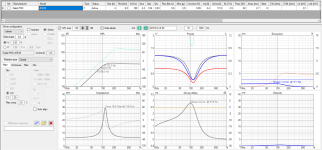
From here, top left SPL graph the blue line shows maximum SPL in this enclosure. The enclosure is what the system thought would work fine and offered it ready there. You could shrink the box size or change to reflex box if you already know what the enclosure is. But let's just use this data. First I just look the light blue line on SPL window, it seems this driver can actually do 100db.
Next I just increase input power to see how much is needed for the driver to make about 100db. I just scroll my mouse on the voltage box to increase input voltage, and look the SPL graph change until it's about at the 100db mark. Now we found out about 30W of power is required. Nice my amplifier is sufficient so this driver seems plausible, it's also the RMS power limit on the datasheet so the driver will survive just fine. As you see the top right graph showing excursion goes beyond xmax, so next thing I want to find out is how low crossover the driver can do 100db. It obviously cannot without highpass filter as the image shows xmax isn't enough so let's add high pass filter.
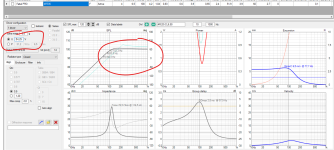
Here I've opened the filter tab and engaged HighPass filter and just using my mouse scroll wheel I move the high pass filter frequency up, looking at the excursion graph, top right, until excursion goes below the xmax line. Now I can read from the graphs that the driver is capable of 100db of output if I have 2nd order high pass at least at ~150Hz.
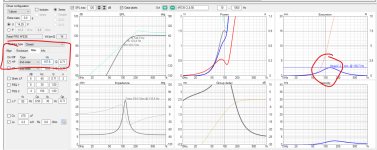
Obviously, the high pass filter could be steeper and higher in frequency and the excursion would go down even further, but this here is the minimum based on datasheet TS parameters. In general, the less excursion, the less there is distortion so you'd likely want to experiment how low you can have the xover before it sounds bad. In practice, you would make a prototype box to try it out, where the crossover needs to be. Prepare to adjust the crossover filter from say 150hz all the way up to 300hz or even higher, in order to make sound change with the 100db/1m output. Now if you think the system as a whole, crossover somewhere beterrn 150-300Hz means the bass section on the system needs to sound fine up to 300Hz at least, which is another task you need now to look at and plan for, if you decide to use this particular mid driver.
Next up, you could look for the frequency response and rest of the datasheet, to try and questimate top end performance to find some hints how high the driver could be used before issues. https://faitalpro.com/en/products/LF_Loudspeakers/product_details/index.php?id=401005150
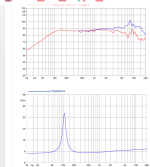
Datasheet says Le (inductance) is very low, which the impedance plot also shows. Also, datasheet reads there is copper cap demodulation, which indicates the motor has got some attention to it, not the cheapest possible so performance is likely fine. The frequency response together with impedance plot wiggle shows anomalies starting about at 3kHz and get worse the higher the frequency. So, you might be fine to run this at least 2kHz and beyond. Directivity for such small driver is also fine for many kiloherz.
These simple analysis based on datasheet indicate the driver might work fine for what you have in mind. But since the data is not from your speaker you haven't even build yet, or heard any sounds, you still need to make it happen to actually listen whether it works or not. So, now you would design the whole system around the mid driver and 3way concept you've chosen. When you are done designing, then buy the drivers, build a prototype box, measure all the drivers in the box, load measurement data into vituixCAD and work out few crossovers: make few xo variations with varying xo frequencies, whatever looks fine by the data, then implement them both and listen which sounds better. Remember to measure the whole system after impelmenting the crossover to make sure there is no mistakes, so that the speaker still measures like it simulates. Now you know whether it worked out fine or not!
If the system is good, build final version of speakers with finished surfaces and all, fix any mistakes / problems you encountered with the prototype speaker, and enjoy. If the system doesn't work out fine, you'd just change your design, build another better structure, perhaps change drivers and so on. It can be a process that rinse and repeat many years 😀 Basically your system quality is directly related to how many things you have been able to notice and fix, which kind of relates how many prototypes you've build. If you build no prototypes, you can be certain the speaker has some issues because you didn't take time to spot them and resolve. When you've built several speakers, you can be certain at least some issues are not there, the ones you were able to notice and resolve. At least some cosmetic issues, physical design of the system for less painful building experience and so on, perhaps some audio issues as well, like bad sounding port noises, sound of midrange distortion, and so on 😉
I hope this thought process explanation is helpful. Have fun!🙂
To check out if 4FE35 would work for 100db / 1m system and for what bandwidth, I'd do this:
Load the driver into VituixCAD enclosure tool. I did nothing else here than increase the bandwidth shown on graphs from 500 > 1000 to see bit better, this is the view:

From here, top left SPL graph the blue line shows maximum SPL in this enclosure. The enclosure is what the system thought would work fine and offered it ready there. You could shrink the box size or change to reflex box if you already know what the enclosure is. But let's just use this data. First I just look the light blue line on SPL window, it seems this driver can actually do 100db.
Next I just increase input power to see how much is needed for the driver to make about 100db. I just scroll my mouse on the voltage box to increase input voltage, and look the SPL graph change until it's about at the 100db mark. Now we found out about 30W of power is required. Nice my amplifier is sufficient so this driver seems plausible, it's also the RMS power limit on the datasheet so the driver will survive just fine. As you see the top right graph showing excursion goes beyond xmax, so next thing I want to find out is how low crossover the driver can do 100db. It obviously cannot without highpass filter as the image shows xmax isn't enough so let's add high pass filter.

Here I've opened the filter tab and engaged HighPass filter and just using my mouse scroll wheel I move the high pass filter frequency up, looking at the excursion graph, top right, until excursion goes below the xmax line. Now I can read from the graphs that the driver is capable of 100db of output if I have 2nd order high pass at least at ~150Hz.

Obviously, the high pass filter could be steeper and higher in frequency and the excursion would go down even further, but this here is the minimum based on datasheet TS parameters. In general, the less excursion, the less there is distortion so you'd likely want to experiment how low you can have the xover before it sounds bad. In practice, you would make a prototype box to try it out, where the crossover needs to be. Prepare to adjust the crossover filter from say 150hz all the way up to 300hz or even higher, in order to make sound change with the 100db/1m output. Now if you think the system as a whole, crossover somewhere beterrn 150-300Hz means the bass section on the system needs to sound fine up to 300Hz at least, which is another task you need now to look at and plan for, if you decide to use this particular mid driver.
Next up, you could look for the frequency response and rest of the datasheet, to try and questimate top end performance to find some hints how high the driver could be used before issues. https://faitalpro.com/en/products/LF_Loudspeakers/product_details/index.php?id=401005150

Datasheet says Le (inductance) is very low, which the impedance plot also shows. Also, datasheet reads there is copper cap demodulation, which indicates the motor has got some attention to it, not the cheapest possible so performance is likely fine. The frequency response together with impedance plot wiggle shows anomalies starting about at 3kHz and get worse the higher the frequency. So, you might be fine to run this at least 2kHz and beyond. Directivity for such small driver is also fine for many kiloherz.
These simple analysis based on datasheet indicate the driver might work fine for what you have in mind. But since the data is not from your speaker you haven't even build yet, or heard any sounds, you still need to make it happen to actually listen whether it works or not. So, now you would design the whole system around the mid driver and 3way concept you've chosen. When you are done designing, then buy the drivers, build a prototype box, measure all the drivers in the box, load measurement data into vituixCAD and work out few crossovers: make few xo variations with varying xo frequencies, whatever looks fine by the data, then implement them both and listen which sounds better. Remember to measure the whole system after impelmenting the crossover to make sure there is no mistakes, so that the speaker still measures like it simulates. Now you know whether it worked out fine or not!
If the system is good, build final version of speakers with finished surfaces and all, fix any mistakes / problems you encountered with the prototype speaker, and enjoy. If the system doesn't work out fine, you'd just change your design, build another better structure, perhaps change drivers and so on. It can be a process that rinse and repeat many years 😀 Basically your system quality is directly related to how many things you have been able to notice and fix, which kind of relates how many prototypes you've build. If you build no prototypes, you can be certain the speaker has some issues because you didn't take time to spot them and resolve. When you've built several speakers, you can be certain at least some issues are not there, the ones you were able to notice and resolve. At least some cosmetic issues, physical design of the system for less painful building experience and so on, perhaps some audio issues as well, like bad sounding port noises, sound of midrange distortion, and so on 😉
I hope this thought process explanation is helpful. Have fun!🙂
Last edited:
Of course you're getting mad, as you don't specify the steepness of the filter i.e. electrical type of filter, its order, and eventually the response of the speaker in exam. Moreover, the other two entities are unknown
Ah ah!
so those numbers are quite meaningless...on the other hand they can tell a lot of a speaker design!This midrange issue is ruin my life really
as i said i have seen xover point between the W and the M ranging from 120 to 1500 Hz and from 2 to 5kHz
the designers have solved the problem in very different ways with very different drivers
i am getting mad
Ah ah!
hi and thank you very much againhehe, lot's of words on this page already 😀
As comparison, here is a another midrange driver that can do 100db at 300Hz with about 2Watts of power and 0.5mm excursion. But, it's got so big cone area (15") it would beam quite bad at few kiloHertz. No problem with distortiom though, so it's system desing issue whether it's important to have 5kHz xo for mid or loads of SPL capbility and consequently low distortion. This midrange with 18" bass could do 116db from 44Hz and up and uplive the neuman minimonitor spec 😀 Anyway, have fun.
i think i understand now that i was underestimating the energy content ar 300Hz Will moving the high pass cut at 500Hz make the task less hard ?
i said 300 but i am willing to move the bar up of course This will imply to use more the woofer
almost any woofer can be used up to 500Hz I will do this and cross fingers
hi thank you very much indeed I understand that with some more effort and tools it can be done with good results Good ! i did not knowOMG! What benefit does a single tone distortion measurement have over the typical wide range sweep, where you can see them all at one glance. Anyway, you must also look at spl response, directivity, CSD etc. to evaluate the total performance in your intended application.
Every freeware FFT analysis software can do sweeps, multitones and single tones and show harmonics up to 6-10th, but the level of those is typically way below noise floor. 3rd and 5th harmonic are most important because they can reveal design and production faults of the specific device under test.
Measurement conditions must be extremely good, a silent anechoic chamber etc. to reliably detect distortions below 0,2%. At home typical noise floor is 30dB. A hobbyist speaker builder should concentrate on the most relevant issues instead of using a microscope, sort of...
View attachment 1405240
from the graph above i see that the driver will behave excellently from about 2kHz up (lower THD) ?
is this kind of graphs helpful in designing a speaker ? i guess so This was my initial opinion
then i got confused
"
a 150mm woven-Kevlar-cone midrange cut at 350Hz if i am not wrong
this means that the energy at 300Hz could be still high ?"
Yes, crossovers don't "cut" usually. By definition they cross over each other, depending on topology/type. But there are very very deep dsp-xo that practically cut 96dB/oct
http://en.wikipedia.org/wiki/Audio_crossover

a 150mm woven-Kevlar-cone midrange cut at 350Hz if i am not wrong
this means that the energy at 300Hz could be still high ?"
Yes, crossovers don't "cut" usually. By definition they cross over each other, depending on topology/type. But there are very very deep dsp-xo that practically cut 96dB/oct
http://en.wikipedia.org/wiki/Audio_crossover
Last edited:
Audax distortion in % looks quite different... This was done in 2013, REW didn't show noise floor. And these don't tell much, they were done with relatively low spl. Just an example that I picked from my archives.
Best source for distortion behaviour of drivers is hificompass.com!
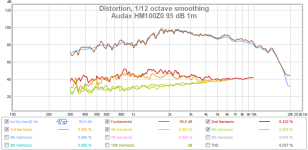
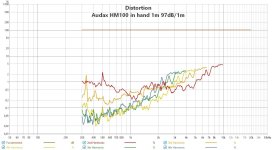
And ten years later when I used it in a 3-way, xo LR3 300/3500Hz. Again quite low spl, but obviously no problems. Again measured indoors with quite high noise floor
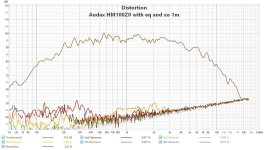
Best source for distortion behaviour of drivers is hificompass.com!


And ten years later when I used it in a 3-way, xo LR3 300/3500Hz. Again quite low spl, but obviously no problems. Again measured indoors with quite high noise floor

Last edited:
To maintain flat frequency response output, volume displacement of a transducer needs to quadruple every octave down. So, if the driver hits xmax at 150Hz with 100db output, it means that 100db output at 300Hz makes only 1/4 of the excursion, is only 1/4 of xmax. So, if assuming that most distortion is due to excursion, crossover at 300Hz is already a great deal better than crossover at 150Hz and if you push it to 500Hz the excursion is 1/10th of xmax (lazy math), with 100db output.hi and thank you very much again
i think i understand now that i was underestimating the energy content ar 300Hz Will moving the high pass cut at 500Hz make the task less hard ?
i said 300 but i am willing to move the bar up of course This will imply to use more the woofer
almost any woofer can be used up to 500Hz I will do this and cross fingers
When you move crossover even a little bit higher, the excursion of the driver goes down, distortion of the driver (whole pass band) goes down.
I personally tend to favor tweeters where odd and higher order distortions are lower than 2nd order. Out of my current favorite tweeters: JBL 2431, Wavcor TW30WA and SEAS 27TDC the Wavecor and SEAS have lower THD but the JBL has lower 3rd and higher orders. I prefer the JBL, however they are all below .25 % at the same typical listening level.One very important distortion measurement is for tweeters. It is primarily the distortion profile that determines how low in frequency a tweeter can be used, assuming you can EQ the response to be acceptably flat in the lower part of its passband. There is really not another better parameter for choosing where (how low) to cross over to a tweeter...
- Home
- General Interest
- Everything Else
- Distortion measurements on loudspeakers _ do they tell anything of value?